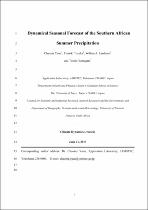JavaScript is disabled for your browser. Some features of this site may not work without it.
- ResearchSpace
- →
- Research Publications/Outputs
- →
- Journal Articles
- →
- View Item
| dc.contributor.author |
Yuan, C

|
|
| dc.contributor.author |
Tozuka, T

|
|
| dc.contributor.author |
Landman, WA

|
|
| dc.contributor.author |
Yamagata, T

|
|
| dc.date.accessioned | 2014-07-30T09:19:20Z | |
| dc.date.available | 2014-07-30T09:19:20Z | |
| dc.date.issued | 2014 | |
| dc.identifier.citation | Yuan, C, Tozuka, T, Landman, W.A and Yamagata, T. 2014. Dynamical seasonal prediction of Southern African summer precipitation. Climate Dynamics, vol. 42(11/12), pp 3357-3374 | en_US |
| dc.identifier.issn | 0930-7575 | |
| dc.identifier.uri | http://link.springer.com/article/10.1007%2Fs00382-013-1923-5 | |
| dc.identifier.uri | http://hdl.handle.net/10204/7539 | |
| dc.description | Copyright: 2014 Springer Link. This is the pre/post print version. The definitive version is published in Climate Dynamics, vol. 42(11/12), pp 3357-3374 | en_US |
| dc.description.abstract | Prediction skill for southern African (16°–33°E, 22°–35°S) summer precipitation in the Scale Interaction Experiment-Frontier coupled model is assessed for the period of 1982–2008. Using three different observation datasets, deterministic forecasts are evaluated by anomaly correlation coefficients, whereas scores of relative operating characteristic and relative operating level are used to evaluate probabilistic forecasts. We have found that these scores for December–February precipitation forecasts initialized on October 1st are significant at 95 % confidence level. On a local scale, the level of prediction skill in the northwestern and central parts of southern Africa is higher than that in northeastern South Africa. El Niño/Southern Oscillation (ENSO) provides the major source of predictability, but the relationship with ENSO is too strong in the model. The Benguela Niño, the basin mode in the tropical Indian Ocean, the subtropical dipole modes in the South Atlantic and the southern Indian Oceans and ENSO Modoki may provide additional sources of predictability. Within the wet season from October to the following April, the precipitation anomalies in December-February are the most predictable. This study presents promising results for seasonal prediction of precipitation anomaly in the extratropics, where seasonal prediction has been considered a difficult task. | en_US |
| dc.language.iso | en | en_US |
| dc.publisher | Springer link | en_US |
| dc.relation.ispartofseries | Workflow;13085 | |
| dc.subject | Seasonal prediction | en_US |
| dc.subject | Southern African summer precipitation | en_US |
| dc.subject | El Nino/Southern Oscillation | en_US |
| dc.subject | ENSO | en_US |
| dc.subject | Southern African summer precipitation | en_US |
| dc.subject | Coupled general circulation model | en_US |
| dc.subject | Relative operating characteristic | en_US |
| dc.subject | Relative operating level | en_US |
| dc.subject | Reliability diagram | en_US |
| dc.title | Dynamical seasonal prediction of Southern African summer precipitation | en_US |
| dc.type | Article | en_US |
| dc.identifier.apacitation | Yuan, C., Tozuka, T., Landman, W., & Yamagata, T. (2014). Dynamical seasonal prediction of Southern African summer precipitation. http://hdl.handle.net/10204/7539 | en_ZA |
| dc.identifier.chicagocitation | Yuan, C, T Tozuka, WA Landman, and T Yamagata "Dynamical seasonal prediction of Southern African summer precipitation." (2014) http://hdl.handle.net/10204/7539 | en_ZA |
| dc.identifier.vancouvercitation | Yuan C, Tozuka T, Landman W, Yamagata T. Dynamical seasonal prediction of Southern African summer precipitation. 2014; http://hdl.handle.net/10204/7539. | en_ZA |
| dc.identifier.ris | TY - Article AU - Yuan, C AU - Tozuka, T AU - Landman, WA AU - Yamagata, T AB - Prediction skill for southern African (16°–33°E, 22°–35°S) summer precipitation in the Scale Interaction Experiment-Frontier coupled model is assessed for the period of 1982–2008. Using three different observation datasets, deterministic forecasts are evaluated by anomaly correlation coefficients, whereas scores of relative operating characteristic and relative operating level are used to evaluate probabilistic forecasts. We have found that these scores for December–February precipitation forecasts initialized on October 1st are significant at 95 % confidence level. On a local scale, the level of prediction skill in the northwestern and central parts of southern Africa is higher than that in northeastern South Africa. El Niño/Southern Oscillation (ENSO) provides the major source of predictability, but the relationship with ENSO is too strong in the model. The Benguela Niño, the basin mode in the tropical Indian Ocean, the subtropical dipole modes in the South Atlantic and the southern Indian Oceans and ENSO Modoki may provide additional sources of predictability. Within the wet season from October to the following April, the precipitation anomalies in December-February are the most predictable. This study presents promising results for seasonal prediction of precipitation anomaly in the extratropics, where seasonal prediction has been considered a difficult task. DA - 2014 DB - ResearchSpace DP - CSIR KW - Seasonal prediction KW - Southern African summer precipitation KW - El Nino/Southern Oscillation KW - ENSO KW - Southern African summer precipitation KW - Coupled general circulation model KW - Relative operating characteristic KW - Relative operating level KW - Reliability diagram LK - https://researchspace.csir.co.za PY - 2014 SM - 0930-7575 T1 - Dynamical seasonal prediction of Southern African summer precipitation TI - Dynamical seasonal prediction of Southern African summer precipitation UR - http://hdl.handle.net/10204/7539 ER - | en_ZA |






